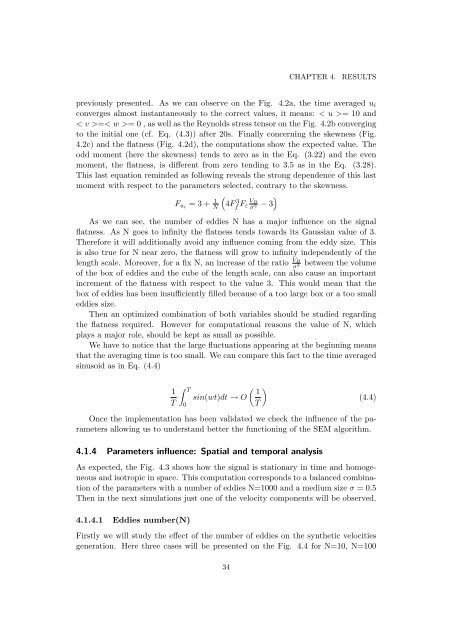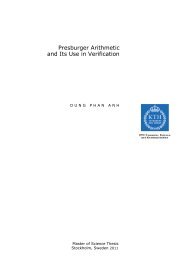Synthetic Inflow Condition for Large Eddy Simulation (Synthetic - KTH
Synthetic Inflow Condition for Large Eddy Simulation (Synthetic - KTH
Synthetic Inflow Condition for Large Eddy Simulation (Synthetic - KTH
You also want an ePaper? Increase the reach of your titles
YUMPU automatically turns print PDFs into web optimized ePapers that Google loves.
CHAPTER 4. RESULTS<br />
previously presented. As we can observe on the Fig. 4.2a, the time averaged ui<br />
converges almost instantaneously to the correct values, it means: < u >= 10 and<br />
< v >=< w >= 0 , as well as the Reynolds stress tensor on the Fig. 4.2b converging<br />
to the initial one (cf. Eq. (4.3)) after 20s. Finally concerning the skewness (Fig.<br />
4.2c) and the flatness (Fig. 4.2d), the computations show the expected value. The<br />
odd moment (here the skewness) tends to zero as in the Eq. (3.22) and the even<br />
moment, the flatness, is different from zero tending to 3.5 as in the Eq. (3.28).<br />
This last equation reminded as following reveals the strong dependence of this last<br />
moment with respect to the parameters selected, contrary to the skewness.<br />
�<br />
1<br />
Fui = 3 + N 4F 3 VB<br />
f Fε σ3 �<br />
− 3<br />
As we can see, the number of eddies N has a major influence on the signal<br />
flatness. As N goes to infinity the flatness tends towards its Gaussian value of 3.<br />
There<strong>for</strong>e it will additionally avoid any influence coming from the eddy size. This<br />
is also true <strong>for</strong> N near zero, the flatness will grow to infinity independently of the<br />
length scale. Moreover, <strong>for</strong> a fix N, an increase of the ratio VB<br />
σ3 between the volume<br />
of the box of eddies and the cube of the length scale, can also cause an important<br />
increment of the flatness with respect to the value 3. This would mean that the<br />
box of eddies has been insufficiently filled because of a too large box or a too small<br />
eddies size.<br />
Then an optimized combination of both variables should be studied regarding<br />
the flatness required. However <strong>for</strong> computational reasons the value of N, which<br />
plays a major role, should be kept as small as possible.<br />
We have to notice that the large fluctuations appearing at the beginning means<br />
that the averaging time is too small. We can compare this fact to the time averaged<br />
sinusoid as in Eq. (4.4)<br />
1<br />
T<br />
� T<br />
sin(wt)dt → O<br />
0<br />
� �<br />
1<br />
T<br />
(4.4)<br />
Once the implementation has been validated we check the influence of the parameters<br />
allowing us to understand better the functioning of the SEM algorithm.<br />
4.1.4 Parameters influence: Spatial and temporal analysis<br />
As expected, the Fig. 4.3 shows how the signal is stationary in time and homogeneous<br />
and isotropic in space. This computation corresponds to a balanced combination<br />
of the parameters with a number of eddies N=1000 and a medium size σ = 0.5<br />
Then in the next simulations just one of the velocity components will be observed.<br />
4.1.4.1 Eddies number(N)<br />
Firstly we will study the effect of the number of eddies on the synthetic velocities<br />
generation. Here three cases will be presented on the Fig. 4.4 <strong>for</strong> N=10, N=100<br />
34

















